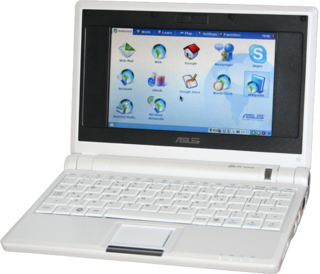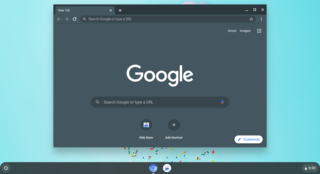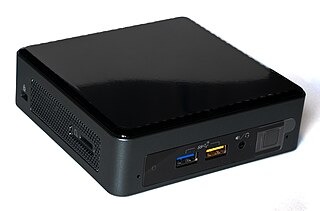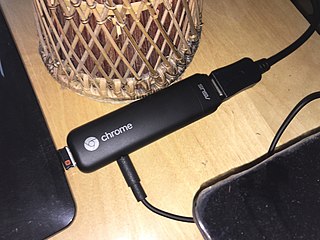A Chromebox is a small form-factor PC that runs Google's ChromeOS operating system. The first device debuted in May 2012. [1]
A Chromebox is a small form-factor PC that runs Google's ChromeOS operating system. The first device debuted in May 2012. [1]
Chromeboxes, like other ChromeOS devices including Chromebook laptops, primarily support web applications, thereby relying heavily on an Internet connection for both software functionality and data storage. That connection, via a local area network, can be wireless or through an Ethernet port.
The machines are classed as small form-factor PCs [2] and typically feature a power switch and a set of connections to support a keyboard, pointing device and one or more monitors. Solid state drives are used for storage and only wireless printers are supported. The first Chromebox, released by Samsung on May 29, 2012, ran a dual-core Intel Celeron Processor 867 at 1.3 GHz, and featured six USB 2.0 ports and two DisplayPort++ slots compatible with HDMI, DVI, and VGA. [1] [3]
In February 2014, Google bundled an Intel Core i7 Chromebox with a business video conferencing package, 1080p high definition camera module, external microphone/speaker and remote control. [4] This Chromebox for Meetings system retailed for $999 plus a $250 annual management fee, waived the first year—a cost thousands of dollars less than other unified videoconferencing systems, including those from Cisco and Polycom. [5] The system employed a Google Hangouts-like interface for up to 15 participants, a dedicated URL for sharing screens, and management accounts for scheduling meetings. [6] An updated system announced in November 2017 featured a 4K camera and a machine learning feature that automatically identifies and frames participants. [7]
In March 2014, Asus established a new price at the low-end of the Chromebox market with a compact, 1.32 pound model that retailed at $179 and featured a Celeron CPU and four USB 3.0 ports. [8] [9] Yahoo Tech columnist David Pogue called the Asus device among the smallest, "least-expensive desktop computers ever sold", likening it to a Smart car. "You won’t be hauling lumber from Home Depot in it, but it’s a terrific deal—and most days, it’ll get you where you want to go." [10] In May, Asus released a faster model with an Intel Core i3 processor. Hewlett-Packard entered the market in June with a Chromebox powered by an Intel Celeron processor, optionally bundling a keyboard and mouse. In August, Acer introduced two models that could stand vertically and provided some business-oriented features, including encryption and fast deletion of local data. In September, Dell entered the market with an entry-level machine, as well as Dell's implementation of the Google video conferencing system. [11]
In August 2015, AOpen announced a family of Chromeboxes designed principally for driving the content of digital commercial signage. The models were ruggedized for on-site operation. [12]
The capability to run Android apps with ChromeOS devices, introduced by Google in 2016 and realized by certain Chromebooks in 2017, seemed to bypass Chromeboxes until a cluster of new Chromebox offerings appeared in 2018, including Acer, [13] Asus, [14] and HP. [15] Oregon-based CTL (Compute Teach Learn), maker of Chromebooks since 2014, launched its first Chromebox in March 2018. [16]
In late 2020, four major Chromebox manufacturers, HP, [17] Acer,[ citation needed ] Asus, [18] and CTL, [19] announced plans for new Chromebox models based on the 10th generation Intel Comet Lake architecture.
| Available | Brand | Model | Processor | RAM | Storage | Size | Auto Update Expiration date [20] |
|---|---|---|---|---|---|---|---|
| 2012-05 | Samsung | Series 3 XE300M22-A01US [1] [3] | Celeron B840 | 4 GB | 16 GB SSD | 1.3 in × 7.6 in × 7.6 in (3.3 cm × 19.3 cm × 19.3 cm) | Mar 2018 |
| 2013-01 | Series 3 XE300M22-A02US | Intel Core i5-2450M | |||||
| 2013-03 | Series 3 XE300M22-B01US | Celeron B840 | 4 GB | 16 GB SSD | 1.57 in × 8.10 in × 8.10 in (4.0 cm × 20.6 cm × 20.6 cm) | ||
| 2014-02 | Chromebox for Meetings [lower-alpha 1] | Intel Core i7 [ which? ] | 4 GB | 16 GB M.2 SSD | 12.4 in × 12.4 in × 4.2 in (31 cm × 31 cm × 11 cm) | ??? | |
| 2014-03 | Asus | Chromebox-M004U [8] | Intel Celeron 2955U | 2 GB | 16 GB M.2 SSD | 4.88 in × 4.88 in × 1.65 in (12.4 cm × 12.4 cm × 4.2 cm) | ??? |
| 2014-05 | Chromebox-M075U | Intel Core i3-4010U | 2 or 4 GB | ||||
| 2014-06 | Hewlett-Packard | HP Chromebox CB1 | Intel Celeron 2955U | 2 GB / 4 GB / 8 GB | 16 GB (128 GB Or more max) M.2 SSD | 4.96 in × 4.88 in × 1.53 in (12.6 cm × 12.4 cm × 3.9 cm) [21] | ??? |
| HP Chromebox [22] | Intel Core i7-4600U | 4 GB / 8 GB / 16 GB | ??? | ||||
| 2014-08 | Acer | Chromebox CXI [23] | Intel Celeron 2957U | 2 or 4 GB | 16 GB | 6.5 in × 5.1 in × 1.3 in (16.5 cm × 13.0 cm × 3.3 cm) | ??? |
| 2014-09 | Dell | Dell Chromebox | Intel Celeron 2955U | 2 GB | 16 GB | 4.9 in × 4.9 in × 1.7 in (12.4 cm × 12.4 cm × 4.3 cm) | Sep 2019 |
| Intel Core i3-4030U | 4 GB | ||||||
| Dell Chromebox for Meetings [lower-alpha 1] | Intel Core i7-4600U | 4 GB | Aug 2019 | ||||
| 2014-08 | Asus | Chromebox CN60 | Intel Celeron 2955U | 2 GB / 4 GB / 16 GB | 16 GB (128 GB Or more max) M.2 SSD | 1.6 in × 4.9 in × 4.9 in (4.1 cm × 12.4 cm × 12.4 cm) | Sep 2019 |
| 2017-07 | Asus | Chromebox 2 CN62 | Intel Celeron 3215U | 2 GB / 4 GB / 16 GB | 16 GB (128 GB Or more max) M.2 SSD | 1.6 in × 4.9 in × 4.9 in (4.1 cm × 12.4 cm × 12.4 cm) | Jun 2021 |
| 2015-03 | Acer | Chromebox CXI [24] | Intel Core i3-4030U (Haswell) | 4 or 8 GB | 16 GB | 6.5 in × 5.1 in × 1.3 in (16.5 cm × 13.0 cm × 3.3 cm) | ??? |
| 2015-05 | Lenovo | ThinkCentre Chromebox [25] | Intel Celeron 3205U | 4 GB | 16 GB SSD | 7.0 in × 7.2 in × 1.4 in (17.8 cm × 18.3 cm × 3.6 cm) | Jun 2021 |
| 2015-08 | AOPEN | Chromebox Commercial [26] | Intel N2930 [27] (quad core Atom) | 4 GB | 32 GB [28] | 6.5 in × 6.2 in × 0.9 in (16.5 cm × 15.7 cm × 2.3 cm) | Sep 2021 |
| 2018-04 [29] | Acer | Acer Chromebox CXI3 4GKM | Intel Celeron 3865U | 4 GB | 32 GB | 5.9 in × 5.8 in × 1.6 in (15.0 cm × 14.7 cm × 4.1 cm) | Jun 2025 |
| Acer Chromebox CXI3 I38GKM | Intel Core i3-7130U | 8 GB | 64 GB | ||||
| Acer Chromebox CXI3 I58GKM | Intel Core i5-8250U | ||||||
| Acer Chromebox CXI3 I716GKM | Intel Core i7-8550U | 16 GB | |||||
| 2018-06 [30] | Asus [31] [32] | Chromebox 3 N017U | Intel Celeron 3865U | 4 GB | 32 GB | 14.9 cm × 14.9 cm × 4 cm (5.9 in × 5.9 in × 1.6 in) | Jun 2025 |
| Chromebox 3 N018U | Intel Core i3-7100U | ||||||
| Chromebox 3 N019U | Intel Core i3-7100U | 8 GB | |||||
| Chromebox 3 N020U | Intel Core i7-8550U | ||||||
| Chromebox 3 N3299U | Intel Core i3-8130U | 4 GB | |||||
| Chromebox 3 N3289U | Intel Core i3-8130U | 8 GB | 128 GB | ||||
| Chromebox 3 N5327U | Intel Core i5-8250U | ||||||
| 2018-06 [33] | HP | HP Chromebox G2 3VD02UT | Intel Celeron 3865U | 4 GB | 32 GB | 5.87 in × 5.87 in × 1.57 in (14.9 cm × 14.9 cm × 4.0 cm) | Jun 2025 |
| HP Chromebox G2 3VD03UT | Intel Core i5-7300U | 8 GB | |||||
| HP Chromebox G2 3VD04UT | Intel Core i7-8650U | ||||||
| HP Chromebox G2 3VD05UT | Intel Core i7-8650U | 16 GB | 64 GB | ||||
| 2018-07 [16] | CTL [34] | CTL Chromebox CBX1 | Intel Celeron 3865U | 4 GB / 8 GB / 16 GB | 32 GB SSD | 5.83 in × 5.85 in × 1.62 in (14.8 cm × 14.9 cm × 4.1 cm) | Jun 2025 |
| 2020-12-05 [18] | Asus | Asus Chromebox 4 | Intel Celeron 5205U Intel Core i3-10110U | 4 GB / 8 GB / 16 GB | 32 GB eMMC 64 GB eMMC | 14.9 cm × 14.9 cm × 4 cm (5.9 in × 5.9 in × 1.6 in) | Jun 2028 |

A netbook is a small and inexpensive laptop designed primarily as a means of accessing the Internet. Netbooks were sold from 2007 until around 2013, when the widespread advent of smartphones and tablets eclipsed their popularity.
In computing, instant-on is the ability to boot nearly instantly, allowing to go online or to use a specific application without waiting for a PC's traditional operating system to launch. Instant-on technology is today mostly used on laptops, netbooks, and nettops because the user can boot up one program, instead of waiting for the PC's operating system to boot. This allows a user to launch a single program, such as a movie-playing program or a web browser, without the need of the whole operating system. There still remain a few true instant-on machines such as the Atari ST, as described in the Booting article. These machines had complete Operating Systems resident in ROM similar to the way in which the BIOS function is conventionally provided on current computer architectures. The "instant-on" concept as used here results from loading an OS, such as a legacy system DOS, with a small hard drive footprint. Latency inherent to mechanical drive performance can also be eliminated by using Live USB or Live SD flash memory to load systems at electronic speeds which are orders of magnitude faster.

AOPEN is a major electronics manufacturer from Taiwan that makes computers and parts for computers. AOPEN used to be the Open System Business Unit of Acer Computer Inc. which designed, manufactured and sold computer components.

The ASUS Eee PC is a netbook computer line from Asus, and a part of the ASUS Eee product family. At the time of its introduction in late 2007, it was noted for its combination of a lightweight, Linux-based operating system, solid-state drive (SSD), and relatively low cost. Newer models added the options of Microsoft Windows operating system and rotating media hard disk drives (HDD), and initially retailed for up to 500 euros.

A mini PC is a small-sized, inexpensive, low-power, legacy-free desktop computer designed for basic tasks such as web browsing, accessing web-based applications, document processing, and audio/video playback.

ChromeOS, sometimes styled as chromeOS and formerly styled as Chrome OS, is a Linux-based operating system developed and designed by Google. It is derived from the open-source ChromiumOS and uses the Google Chrome web browser as its principal user interface.

ChromiumOS is a free and open-source operating system designed for running web applications and browsing the World Wide Web. It is the open-source version of ChromeOS, a Linux-based operating system made by Google.

Chromebook is a line of laptop and tablet computers that run ChromeOS, an operating system developed by Google.

A 2-in-1 laptop, also known as 2-in-1 PC, 2-in-1 tablet, laplet, tabtop, laptop tablet, or simply 2-in-1, is a portable computer that has features of both tablets and laptops.
Atom is a system on a chip (SoC) platform designed for smartphones and tablet computers, launched by Intel in 2012. It is a continuation of the partnership announced by Intel and Google on September 13, 2011 to provide support for the Android operating system on Intel x86 processors. This range competes with existing SoCs developed for the smartphone and tablet market from companies such as Texas Instruments, Nvidia, Qualcomm and Samsung. Unlike these companies, which use ARM-based CPUs designed from the beginning to consume very low power, Intel has adapted the x86-based Intel Atom line of CPU developed for low power usage in netbooks, to even lower power usage.

Next Unit of Computing (NUC) is a line of small-form-factor barebone computer kits designed by Intel. It was previewed in 2012 and launched in early 2013. The NUC has developed over ten generations, spanning from Sandy Bridge-based Celeron CPUs in the first generation through Ivy Bridge-based Core i3 and i5 CPUs in the second generation to Gemini Lake-based Pentium and Celeron CPUs and Kaby Lake-based Core i3, i5, and i7 CPUs in the seventh and eighth generations. The NUC motherboard usually measures approximately 10 × 10 centimetres (4 × 4 in), although some models have had different dimensions.
The Chromebook Pixel is a 2013 laptop at the high end of Google's Chromebook family of machines, which all come preinstalled with ChromeOS operating system. The Chromebook Pixel is part of the Google Pixel series of consumer electronics. An updated model was released in 2015. Chromebook Pixel stopped receiving software and security updates in August 2018.

HP Essential is a trademark used by HP Inc. to denote their entry-level, inexpensive Windows-based laptops. Products under the Essential monicker include the HP Laptop series and HP Notebook series, as well as products simply branded as "HP". There is also a similar line called HP Stream, comprising low-end consumer-oriented laptops and tablets.

The Rockchip RK3288 is an ARM architecture System on Chip (SoC) from Rockchip. It is the first SoC, in August 2014, that uses the 32-bit ARM Cortex-A17 processor. It is a quad-core processor with a NEON coprocessor and hardware acceleration for video and 3D graphics. It is used in a number of Chromebooks and other low-power, low-performance devices.

The Chromebit is a stick PC running Google's ChromeOS. It is able to be plugged into any display via HDMI to act as a personal computer. Keyboards and mice are able to be connected over Bluetooth or Wi-Fi. The device was announced in April 2015 and began shipping November 2015.
The Pixelbook is a portable laptop/tablet hybrid computer developed by Google which runs ChromeOS. It was announced on October 4, 2017, and was released on October 30. In September 2022, Google canceled future generations of the product and dissolved the team working on it.
The Pixel Slate is a 12.3-inch tablet running ChromeOS. It was developed by Google and released on October 9, 2018, at the Made by Google event. In June 2019, Google announced it will not further develop the product line, and canceled two models that were under development. The Pixel Slate was removed from the Google Store in January 2021.

CTL Corporation is an Oregon-based computer manufacturer that produces Chromebooks and Chromeboxes.
The Universal Stylus Initiative (USI) is a non-profit alliance of companies promoting a proprietary technical standard for interoperable active pen styluses on touchscreen devices such as phones, tablets, and computers.